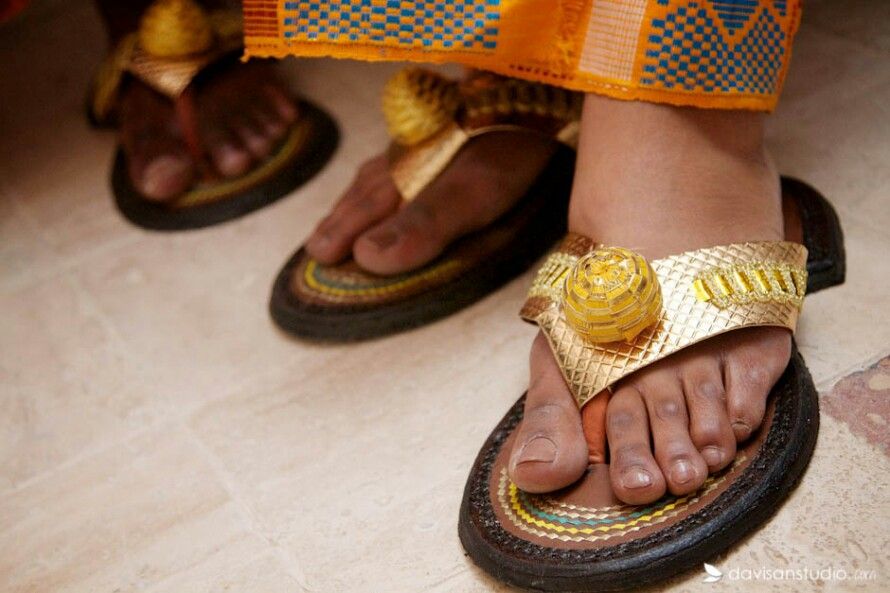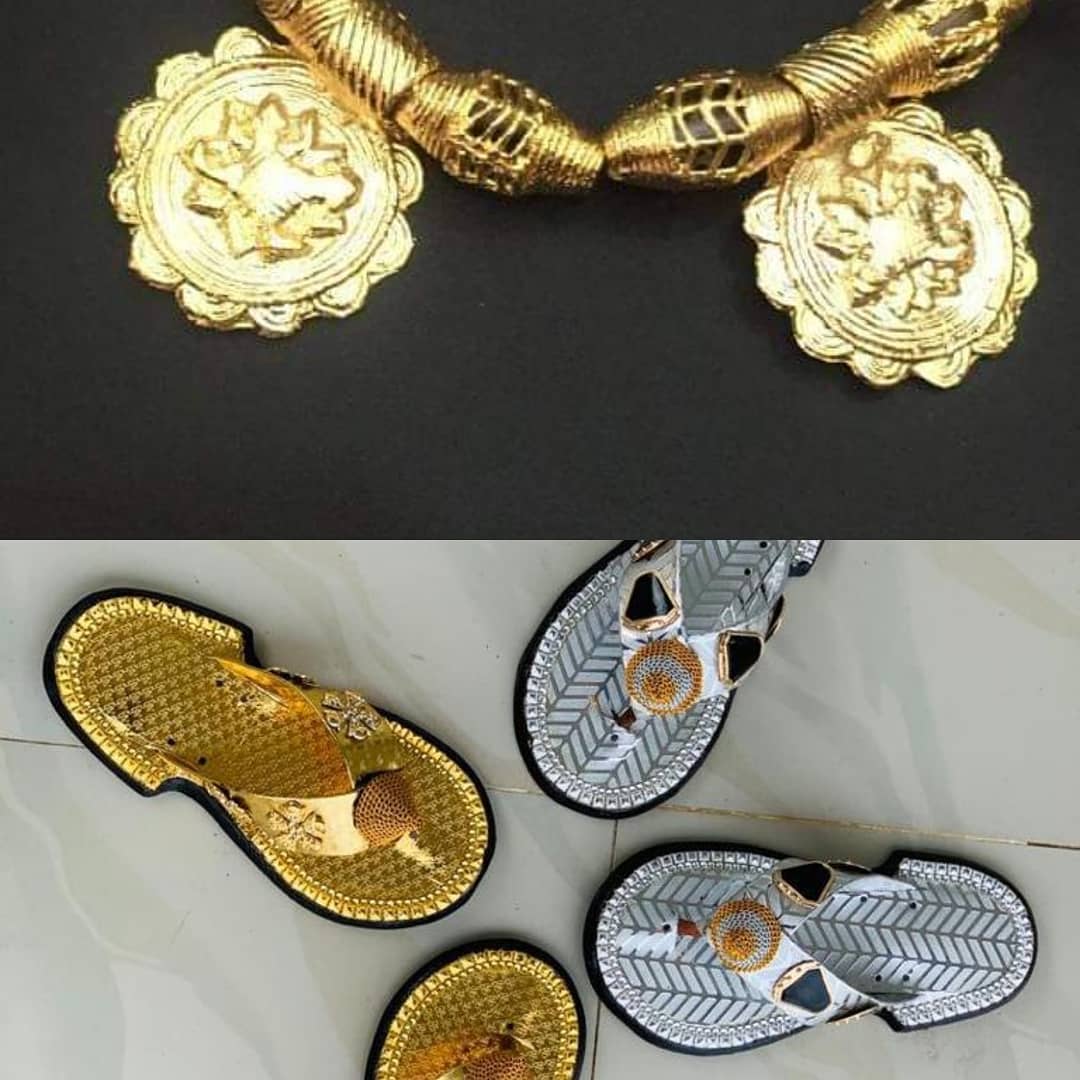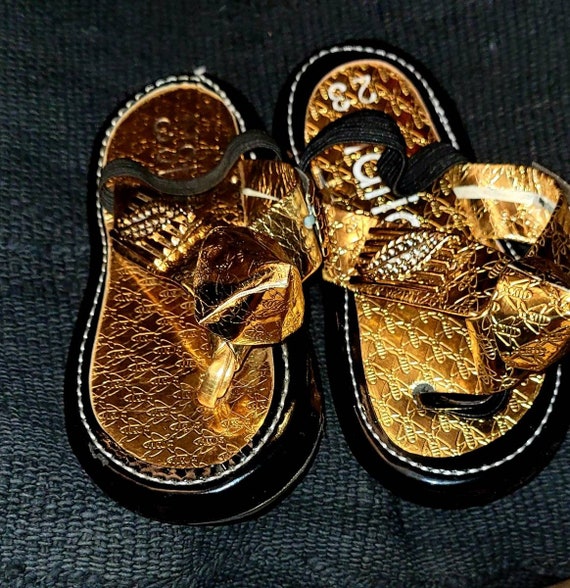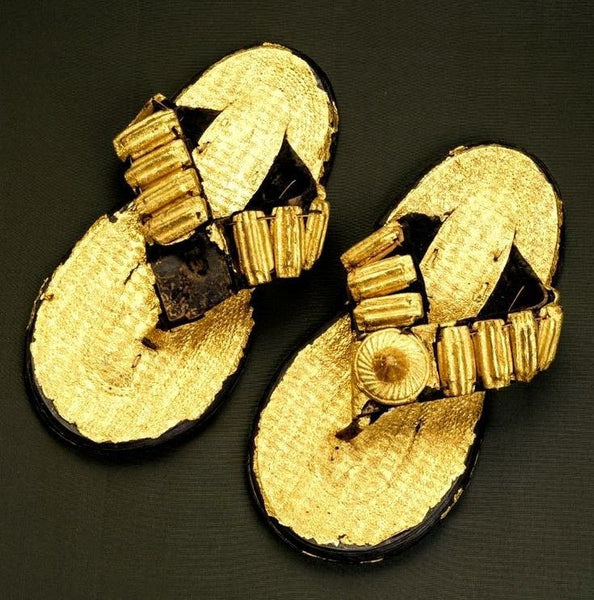Ghana's cultural heritage is richly expressed in local sandals, known as "ahenema" and other traditional footwear. These sandals not only serve practical purposes but also carry cultural significance, symbolizing status, identity, and craftsmanship. 
The art of making slippers and sandals in Ghana dates back centuries, with each pair carrying a story of tradition and culture. Ghanaian artisans, often using locally-sourced materials, have perfected the art of creating footwear that not only embodies comfort and functionality but also showcases intricate designs and patterns unique to the region. Traditional Ghanaian slippers and sandals are often handmade using techniques passed down through generations, with some artisans belonging to families that have been in the trade for decades. These skilled craftsmen infuse each pair with a touch of Ghanaian heritage, making them not just footwear but pieces of art that tell a tale of the country' These traditional footwear pieces are not just items of utility but are also a symbol of Ghanaian craftsmanship, creativity, and heritage.The royal Ohema sandals are a notable example of traditional Ghanaian footwear, specifically associated with the rich cultural heritage of the Akan people and those of the Ashanti Kingdom. The term "Ohema" translates to "queen" or "royalty" in the Akan language, emphasizing the sandals' association with nobility, tradition, and status.
The Craftsmanship Behind Ghana Made Slippers and Sandals
One of the defining characteristics of Ghana made slippers and sandals is the meticulous craftsmanship that goes into creating each pair. From selecting the finest materials to hand-stitching intricate designs, Ghanaian artisans pay attention to every detail to ensure that the final product is of the highest quality. Locally-sourced materials such as leather, fabric, beads, and recycled materials are often used to craft these footwear pieces, highlighting Ghana's commitment to sustainability and supporting local industries. The craftsmanship that goes into making Ghanaian slippers and sandals is a testament to the skill and dedication of the artisans who pour their heart and soul into each pair they create
The Diversity In Design And Style
Ghana made slippers and sandals come in a myriad of designs and styles, reflecting the diverse cultural influences that shape Ghanaian art and fashion. From vibrant and colorful patterns inspired by traditional Kente cloth to minimalist and modern designs, there is a pair of Ghanaian slippers and sandals for every taste and occasion. Some designs feature intricate beadwork and embroidery, showcasing the artistry and attention to detail that Ghanaian artisans are known for.
modern designs, there is a pair of Ghanaian slippers and sandals for every taste and occasion. Some designs feature intricate beadwork and embroidery, showcasing the artistry and attention to detail that Ghanaian artisans are known for.
Ahenema is the most iconic traditional sandal in Ghana. The name translates to "king's or queen's slippers," highlighting its historical association with royalty and nobility among the Akan people, especially the Ashanti and Fante.
The historical origin of ahenema and investigates its socio-cultural relevance in Asante chieftaincy cultural milieu. The study found ahenema as a culturally essential fashion object, whose origin dates back to the eighteenth century, during the reign of the fourth Asante king, Otumfuo Osei Kwadwo Okoawia who ruled from 1764 to 1777; and the queenship of Nana Konadu Yiadom I (whose tenure began in 1768 – 1809). As an essential cultural footwear accessory with densely-layered symbolisms, ahenema became regalia for the chiefdom, a tradition which has remained unchanged; and spread to be multicultural and multinational. Ahenema, has unwavering socio-cultural power in the making of kings/chiefs in Akan culture in the realms of enstoolment and destoolment rituals of Asante chiefs as well as other Akan chiefs as a whole. They are ascribed symbolic, philosophical, and proverbial names which are cultural codes and language that need to be decoded.
The sandals are typically made of leather and feature a unique "V" or "U" shape at the top, where the foot is inserted. The design is considered distinctively Ghanaian, with some pairs decorated with gold or silver embellishments to denote higher social status.
Ahenema were originally reserved for chiefs, royals, and high-status individuals, worn during special occasions like traditional festivals, durbars, and ceremonies. Today, they have become popular among all social classes, worn at weddings, church services, and cultural events.
traditional festivals, durbars, and ceremonies. Today, they have become popular among all social classes, worn at weddings, church services, and cultural events.
The sandals are often paired with traditional kente cloth, reinforcing their cultural importance.
Historical Significance
1. **Cultural Roots**: The Ohema sandals have deep roots in the history of the Ashanti and Akan people of Ghana. These sandals are traditionally worn by women of high status, particularly queens and female leaders, during significant cultural ceremonies and celebrations.
2. **Materials and Craftsmanship**: Traditionally, Ohema sandals are handcrafted, often made from local, sustainable materials. This includes leather or other natural fibers, showcasing not only local craftsmanship but also resourcefulness in using available materials. The handcrafting process reflects the skills passed down through generations, preserving artisanal techniques.
3. **Royal Ceremonies**: Ohema sandals are often associated with formal occasions, including traditional marriage ceremonies, festivals, and royal events. Wearing these sandals in such contexts symbolizes respect for tradition and heritage, as well as a connection to the lineage of Akan royalty.
4. **Symbol of Status**: The sandals serve as an indicator of social status and cultural identity. They are often worn by royals or during royal events, linking the wearer to the historical power dynamics within Ghana's kingdom structures, where kings and queens played pivotal roles in governance, culture, and social order.
Modern Adaptations
Local craftsmen have adapted the ahenema and other traditional sandals for contemporary fashion, incorporating colorful beads, cowries, and intricate stitching.
Artisans in Ghana also create various other locally inspired sandals using leather, jute, or woven materials. Some styles incorporate Adinkra symbols, which are traditional Ghanaian motifs representing cultural concepts or values.
Symbolism
Wearing traditional sandals like ahenema is not just a fashion statement; it symbolizes cultural pride and the preservation of Ghanaian heritage.
The craftsmanship involved in making these sandals often reflects local artisanal skills that have been passed down through generations.
Cultural Significance Today
Efforts are ongoing to promote and preserve Ghana's sandal-making traditions. Cultural festivals, trade fairs, and local markets showcase handmade sandals as part of Ghana’s cultural heritage.
In recent years, Ghanaian designers and fashion brands have embraced traditional footwear, incorporating it into modern collections to appeal to both local and international markets.
These local sandals are more than just footwear; they represent a connection to history, culture, and identity in Ghana.
Social and Cultural Relevance
1. **Cultural Identity**: The Ohema sandals symbolize Ghanaian identity, particularly within the context of the Akan people. As an emblem of cultural pride, these sandals are often worn to affirm one’s heritage and cultural roots, especially during significant cultural gatherings, festivals, or heritage celebrations.
2. **Fashion and Modern Usage**: In contemporary Ghana, Ohema sandals have transitioned from purely traditional footwear to trendy fashion items. Many young Ghanaians, as well as fashion designers, have embraced the design, integrating it into modern apparel while maintaining its cultural significance. This integration helps preserve the heritage while making it accessible and relevant to younger generations.
3. **Preservation of Traditions**: As the world becomes increasingly globalized and fashion evolves, the Ohema sandals serve as a conduit for preserving culture. Through wearing and promoting these sandals, Ghanaians contribute to the continuity of their cultural narratives, educating others about their history and artistic expression.
4. **Economic Impact**: The production and selling of Ohema sandals also have economic implications. Artisans and small businesses engaged in the creation and sale of these sandals provide income for local communities. As demand for traditional and cultural items grows, these crafts can become significant sources of livelihood.
5. **Empowerment and Social Commentary**: The Ohema sandals, representative of femininity and strength, can also be viewed as symbols of empowerment for women in Ghana. Wearing such footwear at culturally significant events can signify a woman’s role in society, reinforcing messages about the importance of female leadership and contribution within the community.
Conclusion
The royal Ohema sandals stand at the intersection of tradition, identity, and modernity in Ghana. They embody a rich historical narrative while adapting to contemporary culture and fashion. As symbols of royal status and cultural heritage, they continue to play an essential role in the social fabric of Ghanaian society, resonating through history, and acting as a bridge between past and future generations. Their relevance extends beyond mere fashion to encompass themes of empowerment, economic activity, and the continuity of tradition in an ever-evolving global landscape.

 modern designs, there is a pair of Ghanaian slippers and sandals for every taste and occasion. Some designs feature intricate beadwork and embroidery, showcasing the artistry and attention to detail that Ghanaian artisans are known for.
modern designs, there is a pair of Ghanaian slippers and sandals for every taste and occasion. Some designs feature intricate beadwork and embroidery, showcasing the artistry and attention to detail that Ghanaian artisans are known for. traditional festivals, durbars, and ceremonies. Today, they have become popular among all social classes, worn at weddings, church services, and cultural events.
traditional festivals, durbars, and ceremonies. Today, they have become popular among all social classes, worn at weddings, church services, and cultural events.




